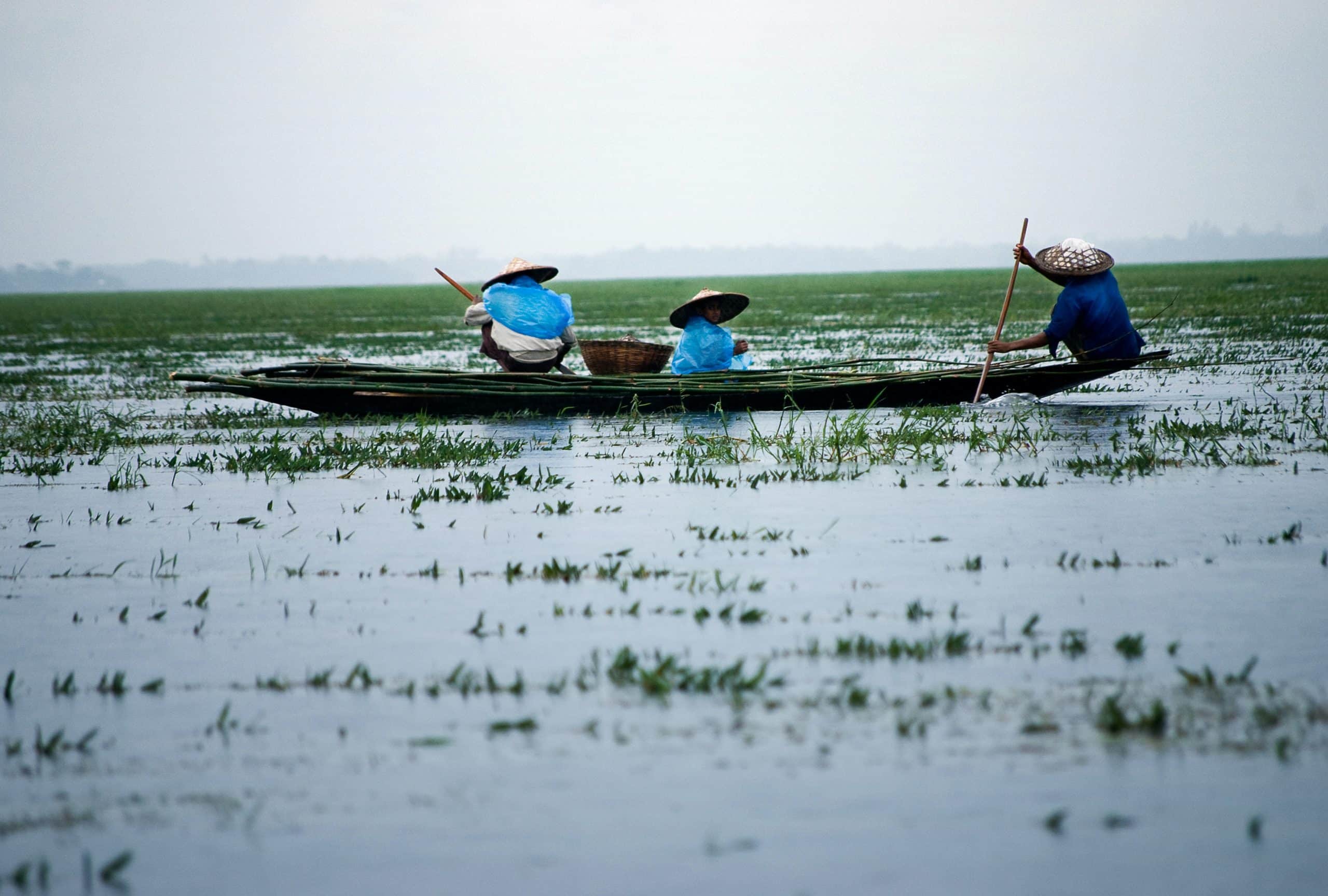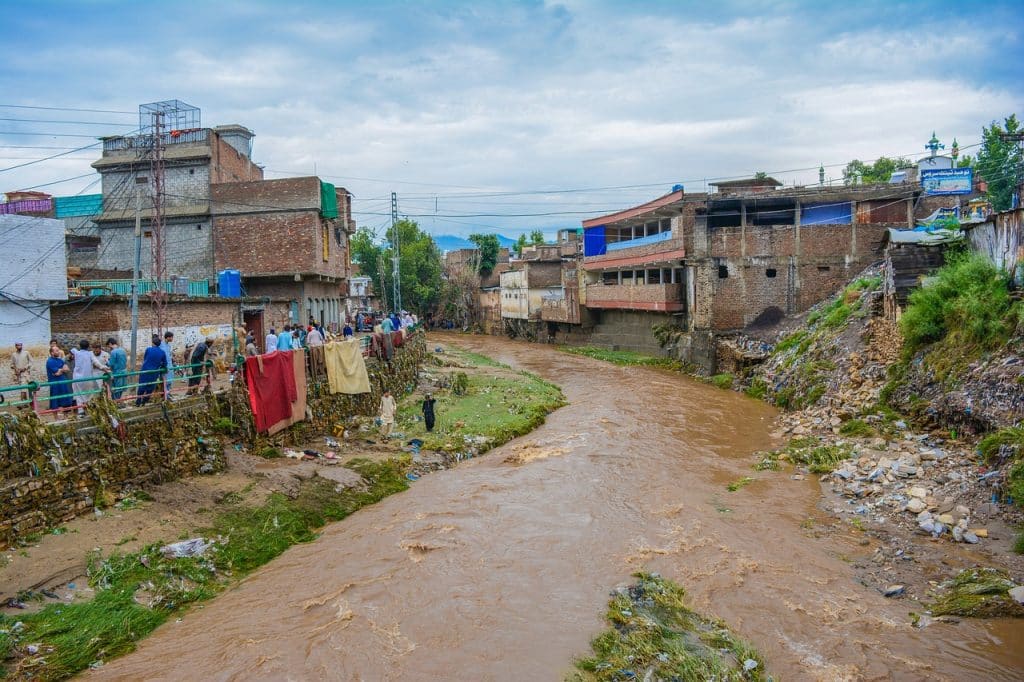As the world grapples with the escalating crisis of climate change, it is becoming increasingly evident that its effects are far from equitable. While the entire planet is feeling the consequences of a warming climate, it is the low-income communities and developing countries that bear the heaviest burden. From disrupted livelihoods to increased vulnerability to extreme weather events, these marginalised populations face a disproportionate impact from climate change that demands urgent attention and action.
—
In the summer of 2022, Pakistan faced the worst floods in its history, affecting 33 million people, destroying over one million homes and flooding 2 million acres of crops. For months, the affected population had no access to clean drinking water, and the standing flood water became a breeding ground for vector-borne diseases like malaria and diarrhoea. The reported number of malaria cases increased from 400,000 nationwide in 2021 to 1.6 million in 2022 in just 60 districts. The floods were unexpected. For the last four years, the region has had drought-like conditions. But in the monsoon season of 2022, rainfall was six to seven times above average. Then, what led to these rains?
Despite emitting only 1% of greenhouse gases (GHG) globally, Pakistan still faces the worst effects of climate change. Warmer temperatures in northern Pakistan melted glaciers, causing rivers to surge, and prolonged heating of the Indian Ocean in the south led to unprecedented amounts of rain.
According to the Sixth Assessment Report published earlier this year by the Intergovernmental Panel for Climate Change (IPCC), the top 10% of income households, including a significant share in developed countries, emit more than 45% of the world’s GHGs, while those in the bottom 50% account for 15% at most.
The International Monetary Fund (IMF) links a country’s GHG emissions to its wealth. The wealthiest countries represent only 16% of the world’s population and emit almost 40% of global CO2 emissions. In contrast, the poorest countries account for nearly 60% of the world’s population, emitting less than 15% of emissions.
You might also like: Floods in Pakistan: An Announced Tragedy?
Effects Of Climate Change On Low-Income Communities
1. Loss of Livelihood
70% of the world’s poor depend on natural resources for all or most aspects of their livelihoods. Among the rural poor and forest-dwelling households, 50-90% of the total source of livelihood comes from ecosystem services and other non-market goods like agriculture, forestry, livestock, and fisheries. Climate change has drastically altered the rainfall patterns and disturbed the growing season, ultimately destroying crops and killing livestock. Farmers in low-income countries lack insurance, unlike their counterparts in wealthier countries, which support recovery from disasters.
Fisheries, too, are affected by climate change. Marine ecosystems are destabilised as the oceans warm up faster than land, causing fish populations to migrate. Marine pollution is also severely disrupting aquatic systems around the world.
2. Food and Water Scarcity
Climate change has slowed agricultural productivity in middle and low latitudes. About 80% of the global population most at risk from crop failures and hunger from climate change reside in Sub-Saharan Africa, South Asia, and Southeast Asia, where farming families are disproportionately poor and vulnerable. A large number of farmers in these regions are trapped in degraded agricultural lands, which further reduces crop production. Low agricultural yield leads to high crop prices, ultimately affecting poor households.
Evapotranspiration, a sum of land surface evaporation and plant transpiration, also increases with global warming. This increases the pressure on already constrained water resources, diminishing water supplies, heat stress, and the prevalence of pests and diseases, ultimately impacting agricultural production.
3. Air Pollution
Air pollution is one of climate change’s most visible impacts. As industrialisation increased, air quality decreased, resulting in a rise in cardiovascular and respiratory diseases. About 7 million people die each year due to poor air quality with South Asia, home to four of the five most polluted countries in the world, accounting for more than half of the total life years lost globally due to air pollution.
While 94% of the global population lives in pollution levels considered unsafe by the World Health Organization (WHO), air pollution is highest in middle-income countries that are economically developing. Improper implementation of air quality regulations, use of older, less efficient machinery and automobiles, subsidy on fossil fuel, rapidly expanding industrial sector, higher population, and unsustainable agricultural practices like cut and burn are responsible for increased air pollution levels.
The impact and exposure of air pollution is different for everyone. Approximately 1 in 10 people exposed to unsafe levels of air pollution lives in extreme poverty. Low-paying jobs often require physical outdoor labour, increasing their exposure to air pollution. Also, due to low cost, most marginalised can low-income communities are located near pollution sources like industrial plants and transport corridors. Lack of access to affordable health care further increases their vulnerability.
You might also like: Air Pollution: Have We Reached the Point of No Return?
4. Climate Refugees

20 million people could be displaced by 2050 in Bangladesh due to rising sea levels. Photo: Ariful Haque/Pexels.
Extreme climate events have displaced an average of 21.5 million people annually. Over the past 30 years, as the sea levels have risen and the intensity of floods and hurricanes worsened, the number of at-risk people in the coastal regions has increased from 160 million to 260 million. 90% of these are from poor developing countries and small island states.
The South Asian country of Bangladesh could lose 17% of its land area to rising sea levels by 2050, displacing 20 million people.
The Lake Victoria region of Africa, one of the most fertile and populated areas, has faced environmental degradation for the last four decades. Yet, with Africa facing the worst effects of climate change, it is estimated that about 16.6 to 38.5 million migrants will move into the region by 2050, further increasing its stress.
You might also like: Climate Migration Is the Crisis of the Century
Ways to Reduce Disparity
As we ramp up efforts to reach the net zero targets by the middle of the century, it is imperative to ensure that the measures taken are inclusive and aimed at reducing inequalities, generating employment, and improving public health. A few steps that could help are:
1. Climate Finance
Economic support plays a huge role in addressing climate change. Developing nations need $127 billion annually by 2030 and $295 billion annually by 2050 to adapt to climate change. Currently, climate adaptation finance stands at about $50 billion per year.
In November 2022, at COP27, the United Nations Framework Convention On Climate Change (UNFCCC) took a massive step in this direction, announcing the agreement on creating a loss and damage fund for vulnerable countries to respond to the impacts of climate change. This will help developing nations establish strong adaptation and mitigation strategies and avoid challenges like insufficient funding, delays in access channels, difficulties in fund allocation, and complexities in existing funds in the face of disasters.
More on the topic: Climate Finance: Are the Rich Nations Doing Enough?
2. Mitigation & Adaptation
Mitigation and adaptation efforts must ensure that no one is unfairly affected in the journey towards net zero emissions. Government policies can play a vital role in reducing inequalities. Efforts like retiring coal-fired plants can be supplemented with programmes to support workers in developing skills needed for new jobs, and revenue generated from implementing new policies like carbon taxes can be directed to benefit low-income communities. In its Sixth Assessment Report, the IPCC identified a range of measures to ensure a just transition to a climate-resilient future.
3. Food and Water Security
Adapting our food production system and efficient use of water resources are essential steps in adapting to new norms set by climate change. Wide disparities exist in the water footprints of affluent and low-income countries and across socio-economic groups within countries.

Half of the global population faces severe water scarcity for at least one month per year.
A few measures that could help address this crisis:
- Creating awareness to reduce food wastage;
- Improving agricultural water management by switching to crops like maize and legume, which require less water for cultivation than rice; addressing water pollution and wastage in food production and supply chain;
- Monitoring water usage and setting limits to consumption in water-stressed regions;
- Using technology to assess accurate water availability through soil moisture sensors and satellite evapotranspiration measurements could help address this crisis.
Soil health also plays an important role in increasing resilience to drought. When organic Carbon in soil is restored, it helps retain water, which in turn helps plants access water more easily. This way, chemical fertilizers could also be reduced, a major source of carbon emissions. There are many ways of restoring soil carbon, like not tilling the soil, crop rotation, and using crop cover with large roots. These natural practices can help meet 37% of the climate mitigation necessary to achieve the Paris Agreement goals.
You might also like: On A Mission to Keep the Magic of Soil Alive: An Interview With Sadhguru
Conclusion
Climate change will drive 68 million-135 million people to poverty by 2030, reversing the decades of economic growth that helped lift millions from extreme poverty and reduced inequalities. Sub-Saharan Africa and South Asia face a dire threat as most of the global poor are concentrated in these regions. The African continent accounts for less than 5% of global GHG emissions, yet it bears the worst brunt of climate change.
While the effects of climate change are disproportionate on society, the solutions must be inclusive, promote equality, protect the rights of the vulnerable sections, and ensure access to basic resources.
In the words of Mary Robinson, former UN High Commissioner for Human Rights: “Without justice, we will not have a fair, healthy, and peaceful world. And without climate justice, we risk not even having a liveable planet for future generations.”
Featured image: Kamran Khan/Pixabay
You might also like: The Problem with Solid Waste Management in Nigeria’s Low-Income Neighbourhoods


















